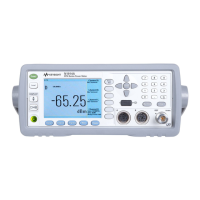Page 19
Find us at www.keysight.com
E-Series E9300 Average Power Sensor Specifications (Continued)
Effects of change in temperature on linearity
Note: If the temperature changes after calibration and you choose not to re-calibrate the sensor, the following additional power
linearity error should be added to the linearity specs in Table 9�
For small changes in temperature: The typical maximum additional power linearity error due to small temperature change after
calibration is ± 0�15%/°C (valid after zeroing the sensor)�
For large changes in temperature: refer to Table 10�
Table 10. Typical maximum additional power linearity error due to temperature change (valid after zeroing the
sensor).
Sensor Power Additional power linearity error
(25 °C ± 10 °C)
Additional power linearity error
(0 to 55 °C)
E9300A, E9301A, E9304A –60 to –10 dBm ± 1.5% ± 2.0%
–10 to 0 dBm ± 1.5% ± 2.5%
0 to +20 dBm ± 1.5% ± 2.0%
E9300B, E9301B –30 to +20 dBm ± 1.5% ± 2.0%
+20 to +30 dBm
± 1.5%
± 2.5%
+30 to +44 dBm
± 1.5% ± 2.0%
E9300H, E9301H –50 to 0 dBm ± 1.5% ± 2.0%
0 to +10 dBm ± 1.5% ± 2.5%
+10 to +30 dBm ± 1.5% ± 2.0%
A+20 dBm
–10 dBm
60 dBm
B+44 dBm
H+30 dBm
+20 dBm, 0 dBm
–30 dBm, –50 dBm
± 2%
± 1%
± 1%
± 2%
A–60 dBm
B–30 dBm
H–50 dBm
–10 dBm
+20 dBm
0 dBm
+20 dBm
+44 dBm
+30 dBm
Figure 2� Relative mode power measurement linearity with an EPM Series power meter, at 25 °C
± 10 °C (typical)�
Figure 2 shows the typical uncertainty in
making a relative power measurement,
using the same power meter channel and
same power sensor to obtain the reference
and the measured values, and assumes
that negligible change in frequency and
mismatch error occur when transitioning
from the power level used as the reference
to the power level being measured�

